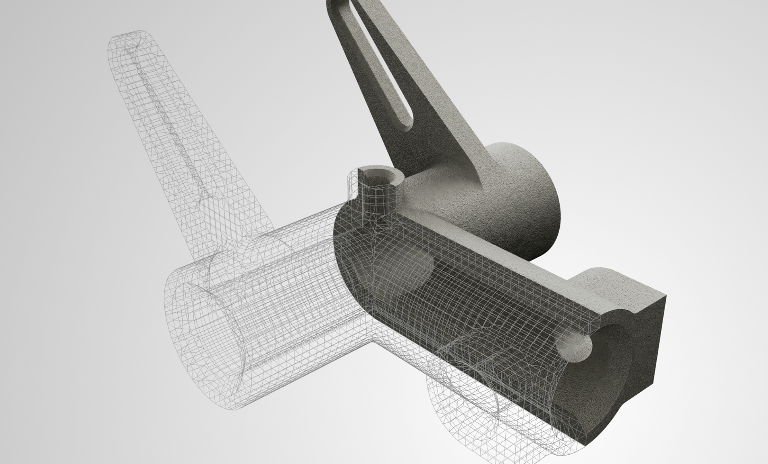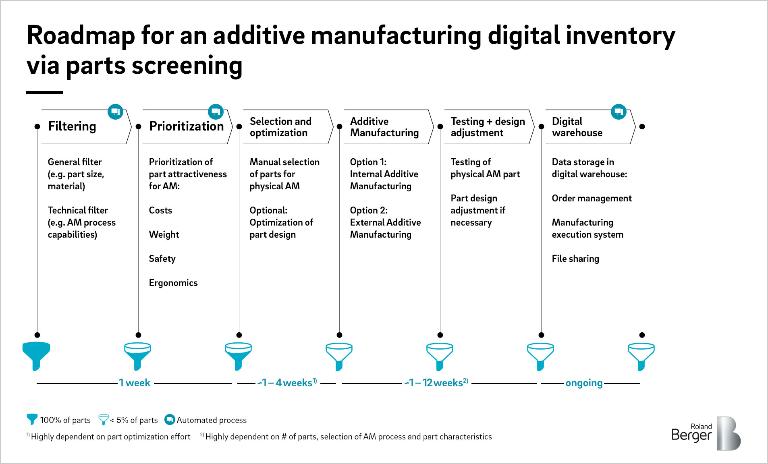

De-risking your supply chain in times of the Coronavirus
How a digital inventory and additive manufacturing can mitigate risks
Amid national shutdowns and border closures business is anything but usual. Complex value chain networks, some with seven supply-chain levels or even more, have been heavily disrupted. Delivering the right product to the right customer in the right quantity and condition at the right place, price and time has become nearly impossible. At the same time, the risk of running out of supply is never larger than during a crisis. But there is also inspiration and creativity to be found. Producers around the world have turned to additive manufacturing to ramp up production of critical components for masks, face shields and respiratory equipment within a matter of days. Some large manufacturers have rapidly pivoted their engineering and operations resources toward corona response. New tools and approaches will be critical in de-risking the supply chain to better manage future crises.

Trend toward regionalization and digitalization of supply chains
There are two major trends that will be crucial to mitigating the risks highlighted by the crisis. As companies consider sourcing decisions, there will be renewed emphasis on prioritizing local-for-local production. However, there will still be limitations due to regional cost differences and existing capacity restraints. Consequently, increased use of digital tools will be an essential part of the solution. A digital twin representing a company's supply-chain provides step-change benefits for simulation, performance measurement and optimization. In the same vein, a digital inventory for parts, including spares, production equipment, and products, has the potential to mitigate supply chain risks in several ways. Having parts digitized and ready for printing, with all necessary information available, are faster to source or make. It also facilitates production via additive manufacturing, even if that option is reserved for emergencies only.
The AM industry has ensured fast and flexible production in the crisis
Shortages of face masks, personal protection face shields and respiratory equipment have provided the perfect opportunity for additive manufacturing to become more prominent. Various companies started to use their existing 3D printers to supply parts and equipment where needed. Additive manufacturing has delivered in times when the supply chain networks have stalled. Decentralized production (see figure 1) has provided a path for additive manufacturing to satisfy especially place, price and time of the seven "rights" of logistics, a path that hadn't been explored in much depth before the crisis. However, it can drive AM success if it is combined with a digital inventory where parts are produced local-for-local plants / production sites?, on-time and without significant stock The Covid-19 crisis created the ideal scenario to use AM: supply shortages, low price sensitivity, need for short delivery times and CAD files ready to print. This situation has allowed companies to take a detailed look at what steps are necessary to create a digital inventory so that parts can be printed from the cloud.
How manufacturing companies can transform existing parts data into 3D-printed parts and leverage the benefits of a digital inventory
While additive manufacturing is usually known for high-end engineering, complex design and fancy applications, the third path of disruption for additive manufacturing is often linked to simple, boring parts. These parts are not visible to organizations and are hidden far away from engineering and design departments in spare parts or product catalogs. For large corporate engineering and manufacturing companies, these catalogs can contain a million parts or more, making it difficult to identify the right parts to additively manufacture. Since AM rarely replaces conventional manufacturing technologies, production methods cannot be switched immediately and parts for AM need to be selected carefully for the full potential of the technology to be realized. Parts well suited for AM include production plant consumables, "jigs & fixtures", production tools such as holders and aligners or complex geometry parts as well as various assemblies. Common barriers when starting the parts selection process include a lack of AM expertise and time/resource constraints which are correlated heavily with the number of cataloged parts. For most companies, this situation leads to an unstructured and inefficient AM part identification process. Printing parts that are not fit for AM wastes time and money and hinders further AM progress.

Figure 2 shows a strategic, semi-automatic and software-based process of how to screen parts to be used for AM. It starts by gathering data from multiple sources then connecting and matching individual metadata, CAD model analysis, production and user requirements. Based on target profiles along different dimensions (the most common profiles are opportunity for value and technical complexity) large amounts of data and part metadata are automatically analyzed to evaluate the AM feasibility.
The resulting part prioritization helps individuals manually select "parts to print". In this manual step, either an experienced user or semi-automatic process selects the best suitable AM technology or material from a list of 10-20 prioritized parts. Future software development aims to minimize the manual process or make the decision process more efficient by using AI and machine learning; however, this advancement might take a couple more years. Optional part design optimization can further increase the part performance and AM suitability (e.g. unnecessary sections of parts can be reduced to save weight or parts can only be "printable" if specific geometry changes are performed).
Having a centralized database with identified parts and data from past orders, CAD, PLM and ERP integration in a digital inventory makes it easier to access AM-ready parts and relevant information such as production requirements, technology and material selection. A single repository is key to ensuring part repeatability and is an enabler for version management and serial production via AM. The integration of an Enterprise Resources Planning (ERP) system to the digital inventory enables the automation of customer and order management. Routine project documentation such as quotes, delivery notes, invoices and shipping documents are automatically generated and can easily be distributed to internal production locations or external manufacturing networks. Information flow to internal production locations can be sped up by connecting the digital inventory to a Manufacturing Execution System (MES). This allows for an efficient AM production, post process scheduling and part tracking.
Software solutions for such a digital AM ecosystem are already available on market, but not as plug-and-play solution. While large corporations are already using these software solutions, SMEs especially are still struggling to adapt. Since not all process steps from part identification to a finished AM part are fully automated, a lack of AM expertise might be a barrier to comprehensive adaption. This might change in the next 3-5 years if the software can fully automate the process. Furthermore, there is no "one-size-fits-all" software solution that will work for every company. Adjustments to the utilized algorithms to fit individual company characteristics will be cost and time intensive. Without quality data available, the algorithms cannot be used to seamlessly identify parts and eliminate manual work. Common issues include limited availability of 3D-CAD data and parts metadata. In addition, additive manufacturing technology is far from being ready for all parts or purposes and not all required certifications and tests are ready to be used in a manufacturing environment.
Clients have significantly improved their businesses by using parts screening for AM and a digital inventory
Companies that have been able to use the automated part identification tool were able to determine reasonable AM business cases from a large number of parts within a short period of time. By managing these identified components in a digital inventory, companies have seen benefits on various level (e.g. costs, weight, lead-time, inventory working capital, safety and ergonomics.
Another benefit is that AM spare parts in a production plant can be 70% cheaper compared to conventional manufacturing. On average, 5% of the parts have a savings potential of 20%, reducing the inventory of working capital. In addition, the average lead time for a complex made-to-order part can be reduced from weeks to days. By minimizing storage and removing stock-keeping, additional costs can be saved. Weight reduction via finite element parts optimization for specific mechanical load cases may be up to 30% or in extreme cases 60% per part which can lead to further benefits. For example, the reduced weight of a gripper on a robot arm in a packaging plant can increase the plant output by 2-3% if the packaging machine is the bottle-neck and can run faster with a lighter AM-gripper. Weight reduction for manually lifted tools will help employee health and safety by preventing injuries/accidents. The employee sickness rate will decrease as back injuries from lifting heavy parts fall.
About 2-4% of the screened parts have been identified to be attractive for AM technologies. Companies can use digital inventories through the automated parts screening done by different industries (e.g. logistics, automotive, industrial products, consumer goods, healthcare and others) to de-risk parts of their supply chain. For AM to be successful, the critical starting point is usually collecting the parts/product data from different sources including 2D/3D-drawings, materials/application as well as logistics and sales. Since this barrier is quite common, the advantages of a digital inventory might be embedded within a larger digitalization initiative and combined with the supply chain digital twin. We at Roland Berger can assist you in the journey for a digital inventory.
For questions please contact us.


_image_caption_none.jpg?v=770441)



